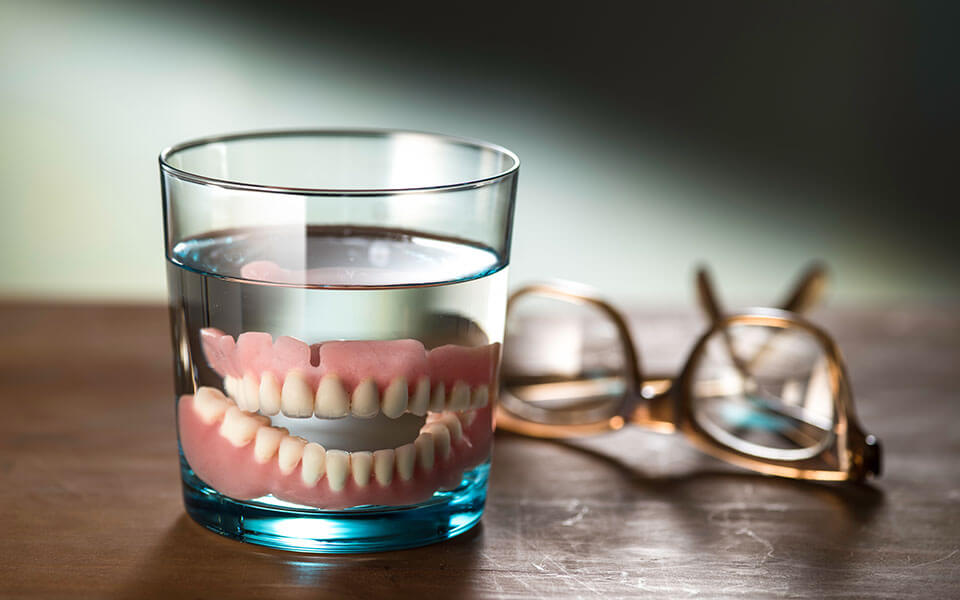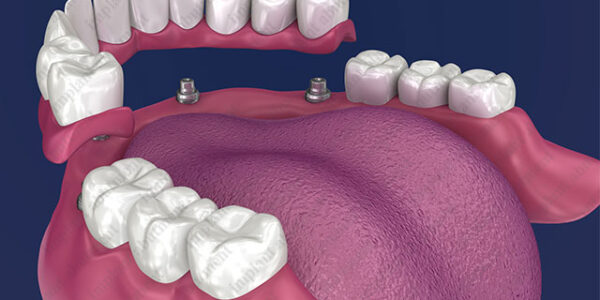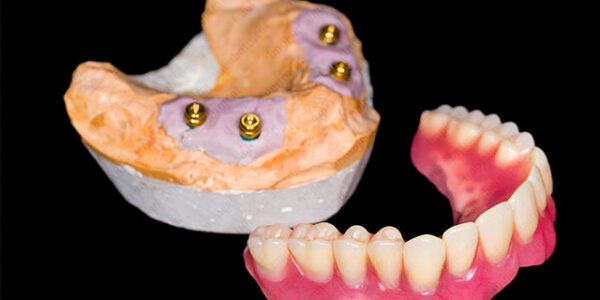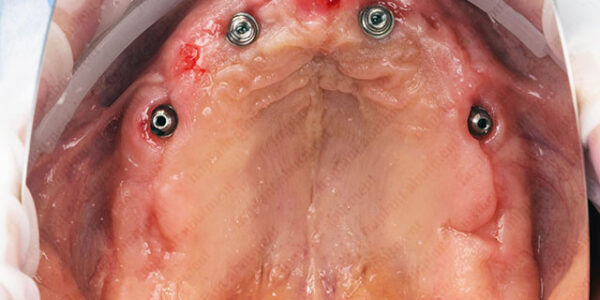Dentures versus implants: Contemporary solutions for edentulism patients
Edentulism, also known as complete tooth loss, can be due to a variety of oral health complications such as vertical tooth fracture, trauma, disease or abscess formation. Tooth loss that is unattended to can lead to decreased masticatory performance and most often causes progressive alveolar bone resorption. Not only does this affect a patient’s overall mouth function in everyday activities such as eating and speaking, but the struggle with these incompetencies can have a secondary negative impact on the patient’s psychosocial wellbeing. Thus the necessity to replace lost teeth is indeed a matter of functionality, but is also crucial for a positive quality of life. This article examines the differences of dental implants vs dentures.
What are the tooth replacement options?
The current treatments available for edentulism include bridges, removable dentures and implants.
Dentures Bridges
Dental bridges, also known as fixed partial dentures, are divided into two categories: tooth-supported bridges and resin-bonded bridges. The former involves reshaping the two teeth surrounding the missing tooth gap by shaving them down to a smaller size. These two teeth, serving as abutment teeth, will support the bridge with a crown that goes over each one, with the prosthetic tooth attached between them. Resin-bonded bridges, the second category of bridge, have wings on each side of the fake tooth that attach to the backside of the healthy teeth on either side of the gap. This type of bridge is often considered for the front of the mouth, for teeth that don’t need to bear a high force load from biting and chewing, as those teeth in the back of the mouth do.
While these bridges often look and function better than a removable denture, they are not as strong and don’t last as long. Both types of bridges do not stimulate any kind of bone growth around the edentulism site, often resulting in localized bone loss over the long term. Due to their structure, bridges are often difficult to clean properly, leading to root decay and ultimate failure of the bridge after five to ten years.
Removable dentures
Removal dentures were, in the past, the most common treatment for edentulism, restoring the patient’s ability to chew and speak. This solution is also less invasive than tooth-supported bridges, as there is no need to reshape and shave down the surrounding teeth. However, lack of stability and retention, along with more serious long-term effects such as progressive bone loss, have caused an increase in the number of edentulous cases resorting to dental implants as an alternative.
Some insurance companies have begun to recognize the significantly negative impact on long-term health that removable dentures have and will offer to help cover or entirely cover the costs of an implant procedure. That being the more uncommon outcome, particularly with regard to international healthcare systems, for some patients removable dentures are the only solution due to economic limitations. For other patients, removable dentures are the only solution due to physical health limitations such as blood clotting disorders or bone disease.
Removable dentures can be divided into two categories: removable partial dentures and removable complete dentures. Partial dentures are a system involving prosthetic teeth embedded into a removable clasp retainer, filling in missing teeth, but not the entire row. This can be a good alternative for patients whose teeth are not strong enough to hold a bridge, or for those who have more than just a few teeth missing.
Complete dentures, commonly known as ‘false teeth,’ are removable acrylic tooth replacements that sit on top of the gums and are intended for cases in which teeth are lost over the entire arch. Both systems of removable dentures are intended to be regularly placed and removed from the mouth, making them a poor solution for tooth replacement with regard to mastication and the necessary response to functional load that goes with it.
Implants
An implant system involves the drilling of small screws, often made of titanium, into the jaw and bone socket. The healing process after this surgery, in which the tissue around the implant heals and the bone fuses with the implant (i.e. osseointegration), can take anywhere from two to nine months. After healing is completed, the prosthetics are fixed onto the implants.
In the case of patients who need only one or a few teeth replaced, implants are ideal as they provide more support and are more easily maintained than dentures. Whole arch replacement is another option, with a good solution being the ‘All-on-4’ full arch restoration — a system of four implants to complete the entire arch’s teeth replacement.
It must be noted that the prerequisites to getting implants are stricter than those of other tooth replacement solutions, as the system is more invasive and must meet certain health requirements. Oral health is the first and most important requirement for implant candidates: presence of any complications such as gum disease and tooth decay must be treated before the patient can be considered. Anatomical restrictions such as small jaws can cause complications in terms of weight load and ability to support a standard implant. These patients may be candidates for bone grafting, which would allow them thereafter to support an implant system. This procedure would not be an option for any patients suffering from blood clotting diseases, bone disorders or immune system deficiency. For those patients seeking implants who are smokers, it is ideal for improved chance of implant success that the patient stops smoking. Patients who grind their teeth are not suitable candidates for dental implants.
Dentures versus implants: A back-to-back comparison
Cost
In the initial price, dentures most certainly cost less than implants. However, with a shorter lifetime than implants, dentures will need to be replaced in as little as five years, and as much as 15. That means that after the repeated costs of the denture system, plus the ongoing maintenance costs associated with them (e.g. fixatives, adhesives, cleaners), over the long run the costs can actually exceed those of implants. What’s more, with no structures to support the jawbone, bone deterioration will occur, which can result in other health complications.
Timing
A patient can be fitted for and receive dentures much sooner after extraction than implants, which must heal before the final implant system can be placed. Due to the sensitivity of the implant process, the number of appointments and waiting time can be significantly more than with dentures, particularly if the patient needed a bone graft or if there are healing complications.
Invasiveness of procedure
Apart from tooth-supported bridges, which require the physical altering of the gap’s two surrounding teeth, dentures are relatively non-invasive. Implants, on the other hand, require the patient to undergo a surgical procedure in which screws are implanted into the jawbone. If the patient requires a bone graft, this procedure is significantly invasive and painful.
Care
While implants are essentially considered as normal teeth with regard to care (i.e. regular brushing and flossing), dentures require more of a time investment. Removable dentures must be removed regularly, brushed and soaked. Tooth-supported bridges, on the other hand, need to be flossed differently than regular teeth, accessing the space below the bridge in order to avoid root decay.
Esthetic & function
Regarding dentures, patients have the option to choose between fixed (implant-retained) or removable systems. Regardless of the system, dentures often do not feel or look as natural as implants. Dentures are also less stable than implants and are subject to moving, slipping or clicking in the mouth when chewing, laughing, talking and kissing. With implants, which have a feel and function of natural teeth, these issues are not present. Furthermore, the patient has full function of mastication, unlike with dentures, where the patient’s diet may need to eliminate certain foods that are not suitable for dentures.
From a functional health standpoint, implants are far superior than dentures, as they stimulate new bone growth in the jaw that prevents it from deterioration and shrinking. In dentures, on the other hand, the natural bone in the jaw can deteriorate over time, not only causing secondary health complications, but changing the structure and appearance of the face and smile.
Longevity & durability
When taken care of, implants will last far longer than dentures, sometimes for decades. The lifespan of dentures, on the other hand, is usually no more than 15 years, but can be as short as five. As dentures are more easily damaged than implants and are constantly removed and replaced from and to the mouth, they are more susceptible to breakage.
Dentures vs. implants: The take-home message
When looking at the two types of dental restoration systems back to back, it is clear that the advantages of implants far supersede those of denture systems. When in good health, choosing dental implants over dentures will not only provide the patient with a longer-lasting, healthier product, but will also allow for a much higher quality of life.





